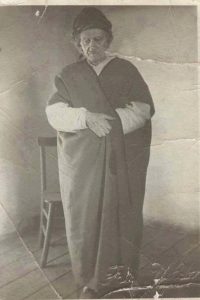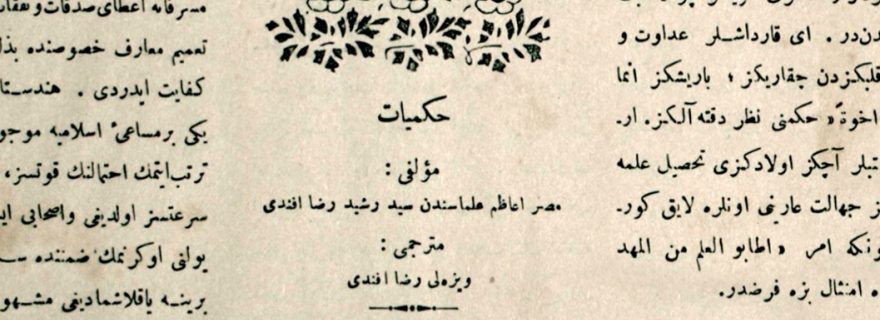Modernist Islam, Isrāʾīliyyāt, and Saʿīd Nūrsī
Since the late nineteenth century, Modernist Muslim commentators have argued for the ejection of “foreign” texts, Isrāʾīliyyāt, and a return to an “untainted” Islam. In academic literature, however, the connections between the late-Ottoman ʿulamāʾ and the Arab Modernist exegetes are often neglected.
In the late nineteenth and early twentieth centuries, Isrāʾīliyyāt — a long-forgotten, pejorative term which referred to the parts of the Islamic tradition with alleged Jewish origins — was re-introduced to the global Muslim agenda. The polemics surrounding Isrāʾīliyyāt were re-discovered, extended, and popularised in Egypt by the influential works of Muḥammad ʿAbduh (d. 1905), Rashīd Riḍā (d. 1935), Maḥmūd Abū Rayya (d. 1970), and their followers, who wrote extensively on the idea of returning to a “pure” form of Islam which was incidentally in full accordance with the “needs” of the modern world. They argued, with varying degrees of rigidity, that extra-Qurʾānic sources (notably some ḥadīths and books of exegesis) had been corrupted by the inclusion of this Jewish, and thus “alien” material. Their arguments were often visibly unscientific and hostile, and any narration that was deemed unfit to the Modernist ideology could be labeled as Isrāʾīliyyāt.
The aforementioned scholars and their successors around the Islamic world launched a campaign against the so-called Isrāʾīliyyāt. These ideas travelled extensively in the Muslim world with the aid of printing technology. Perhaps the most famous of such publications was ʿAbduh and Riḍā’s joint work al-Manār (published between 1898-1935). It is no surprise that this new critique of Isrāʾīliyyāt emerged as a part of the wider rejection of the extra-Qurʾānic traditions as a whole. In this period of intense debates about Islamic reform, all of the aforementioned scholars argued for relying on the Qurʾān to interpret the Qurʾān.
Blaming “superstitious,” “absurd,” or “unscientific” traditions on malevolent Jews proved to be useful in convincing the masses that Islamic reform was a necessity. According to these scholars, converts from Judaism in the early years of Islam had carried out a deliberate mission to taint the faith with superstitions from their own religious traditions. With the rise of Zionism in the early twentieth century, the ʿulamāʾs war on Isrāʾīliyyāt intensified. Comically symbolic of the ahistoricity of this ideology, Abū Rayya had famously called one such convert Kaʿb al-Aḥbār (d. 652-3? CE) “the first Zionist” for his alleged role in transmitting such material (Kaʿb al-Aḥbār huwa as-Ṣahyūnī al-Awwal).


A contemporary of the aforementioned Egyptian writers was an Ottoman-Kurdish ʿālim and proponent of religious reform, Saʿīd Nūrsī (d. 1960), also known as Saʿīd Kurdī. He was in close connection to the Modernists in Egypt and considered ʿAbduh his intellectual predecessor. Due to his relentless pro-reform activism he was at odds with the Ottoman and later secular-Turkish political authorities. Like the Modernists in Egypt, Nūrsī made use of the novel print media and between 1908 and 1909 wrote for journals like Kürd Teʿāvūn ve Teraḳḳī (“Kurdish Solidarity and Progress”) and Şarḳ ve Kürdistān (“The East and Kurdistan”). A translation of an article by Rashīd Riḍā was published in the former journal’s penultimate issue, in which he was presented to the readership as “one of the great scholars of Egypt, Sayyid Rashīd Riḍā Efendi” (mıṣır aʿāẓīm ʿallāmesinden). In many parts of his tafsīr (Qurʾānic exegesis) called Risale-i Nur (Treatises of Divine Light), Nūrsī critiqued the Isrāʾīliyyāt in a way that is comparable to those of his intellectual influences. He wrote that his goal was to “rescue Islam from fables, from the Isrāʾīliyyāt, and cold bigotry” (İslâmiyeti, onu paslandıran hikâyat ve İsrailiyat ve taassubat-ı bârideden kurtarmak). However, his critique of Isrāʾīliyyāt was not as political, and he did not interpret its supposed permeation in Islam as a Jewish plot. Nevertheless, he also pointed out the role of the converts:
The tampered Isrāʾīliyyāt got mixed up with the pure thoughts [of Arabs] via ... [the narrations of] the ʿulamāʾ of the People of the Book like Kaʿb [al-Aḥbār]… And later they received respect. Because those among the ʿulamāʾ of the people of the book who entered Islam received eminence ... and so their menacing, older narrations came to be regarded as agreeable and proper ... Because when stories that did not go against the ways of Islam were narrated, they were listened to without censure due to their [perceived] unimportance. Alas, they were later accepted as truth. … |
More than a century after its inception, the “problem” of Isrāʾīliyyāt remains a hotly debated issue among the ʿulamāʾ in Turkey, and celebrity preachers of all views can be found commenting on it online. This new-found fascination with the subject has to do with the revival of the Turkish ʿulamāʾ, following the Islamization of the public sphere in the recent decades and the opportunities offered by internet platforms like YouTube. Proponents of Islamic reform who specialize in exegesis talk about Isrāʾīliyyāt also in their books and TV appearances, and are strongly influenced by the likes of ʿAbduh, Riḍā, and Abū Rayya. These contemporary polemicists include well-known public figures like Bayraktar Bayraklı, Mustafa İslamoğlu, Mehmet Okuyan, and Caner Taslaman.
Surprisingly, such proponents of reform who lead the crusade against Isrāʾīliyyāt do not refer to Nūrsī’s views on this subject, and Nūrsī is not credited as the first person in the Turkish context to engage in a systematic criticism of it. This is not because he is an unfamiliar or negligible figure — on the contrary, he is perhaps one of the most well-known Islamic scholars of the country. Nevertheless, they opt to import ideas and arguments against the extra-Qurʾānic traditions (and Isrāʾīliyyāt in particular) directly from the Egyptian School, bypassing the “local experience” with Islamic Modernism (which was actually in close connection with the intellectual scene in Egypt).
There is arguably a deliberate attempt to ignore Nūrsī’s input, since a reference to him might entail certain political transgressions. Nūrsī was delegitimized as a religious fundamentalist and a pro-Kurdish secessionist by the official discourse in Turkey for decades. He was exiled, his works were banned, and even his grave was destroyed by the secularist regime that wanted to condemn him to a damnatio memoriae. Referring to Nūrsī might not appeal to the Modernists who aim to be politically agreeable in order to reach as many people as possible in the polarized Turkish society.
Notwithstanding the current negligence of Nūrsī’s input on Isrāʾīliyyāt, his work remains valuable for a student of Islamic studies, and it remains a proof of the existence of an intellectual bridge between thinkers of Modernist Islam of the late nineteenth and early twentieth centuries. If we are to better understand the diffusion and impact of Modernist Islam in the late Ottoman context, the works of Saʿīd Nūrsī should be of foremost importance.
This blog is based on and includes excerpts from S. Berk Metin’s Research Master Thesis entitled De-Judaising Islam: Isrāʾīliyyāt Discussions in Turkish New Media (2020).



0 Comments